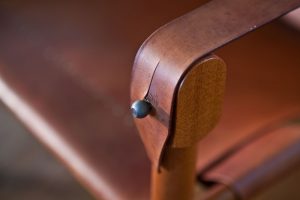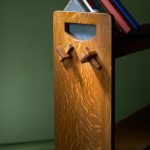We may receive a commission when you use our affiliate links. However, this does not impact our recommendations.
When you build furniture that hasn’t been popular for a century, the hardware can be difficult to find. The Roorkhee chairs I’m building for a fall issue of Popular Woodworking Magazine feature an unusual stud that gave me fits.
It’s a simple metal nipple at the top of each leg. The chair’s arm straps wrap over the top of the leg and fasten to the nipple.
Some leatherworking sources call this a “Sam Browne” button or a “button stud.” And they are a common item. However, they are not designed to be attached to wood. So my first move was to modify a button stud. I found some metric threaded rod that would screw nicely into the back of the stud. I then epoxied the rod into the stud and then threaded the wood to accept my Franken-stud.
It worked just fine, but I wanted to find a simpler solution to suggest for readers building this chair. Plus, I wanted to use a slightly larger stud to match some historical chairs.
After searching the Internet for a few hours, I found a good solution: 10mm or 13mm ball studs designed for gas cylinders on cars. I know, I know. I’m sure you read that last sentence and thought, “That’s not in English.”
These ball studs thread into the sheet metal of a car or a camper top for a pickup truck, for example. Then an articulating gas cylinder snaps onto the stud. This is the piece of hardware that holds the gas pistons that hold a car’s hatchback – or any hinged piece of glass – in the “up” position. In fact, I have these exact pieces of hardware on my car.
I ordered some of these 13mm ball studs from a seller on eBay, but they are available from many automotive supply stores. The 13mm ball stud has 5/16” SAE threads, a 1/2” hex nut that is like a collar between the threads and the ball stud, which measures 13mm, of course.
The only downside to the hardware is that it is typically zinc-plated, which is just ugly.
To remove the zinc from all the hardware for this chair I soaked it in citric acid, a weak acid used in canning, flavoring food, cosmetics and cleaning. You can buy the powder from health-food stores or occasionally at a good grocery store in the canning section.
If you need citric acid at 11:30 p.m. on a Sunday, pick up a box of “Sure Jell Premium Fruit Pectin” in the canning section. It’s used in making jams and jellies and has enough citric acid to do the job, and its other ingredients (dextrose and pectin) do no harm.
I put about half an ounce of Sure Jell in a glass spaghetti sauce jar and filled it two-thirds with water. I plopped the zinc-plated stuff in the solution, shook it and let it sit overnight. By morning, the zinc was gone and the dull steel below was revealed. Sweet.
I rinsed off the hardware in water – citric acid can go down the drain just fine – and oiled it to delay rusting.
Installing the hardware is easy. I drilled a 1/4” hole in each leg and threaded the hole using my grandfather’s tap-and-die set. I didn’t thread the hole all the way down; I left about 3/16” unthreaded at the bottom. I then screwed the hardware into the hole. The teeth on the ball stud cut the last few threads in the hole, tightening everything up.
All this sounds a lot more complicated than it really is. But the extra couple steps really made the details of this chair look spot-on.
— Christopher Schwarz
Hey, I have a new two DVD set called “Mastering Hand Tools,” which is available through ShopWoodworking.com. It covers all the basics that you need to know to get started in hand tools without spending a ton of money on tools or jigs.
Here are some supplies and tools we find essential in our everyday work around the shop. We may receive a commission from sales referred by our links; however, we have carefully selected these products for their usefulness and quality.















Question for you Chris,
I see in the pic, you are using a tap and die set, I have a metal working one. I have seen on tool sites that there is such a thing as tap and die sets FOR wood, is there a difference? And is that what you are using?
I agree with hereswhatidid, I save all sorts of odd ball junk from about anything we are trashing. I have one of those 24 drawer plastic bins that I sort them into for buttons, caps, whatever. Never know when it will come in handy. At first glance I thought you were using a grease joint for a car!!!
Another option for the knob could be lamp hardware. They have all kinds of styles of decorative metal ends for the top of the lamp as well as the on/off switches.
Brass rod turns and treads easily enough that ball studs would not be difficult to make if you have access to a lathe. To me, the brass would be more appealing than the “car parts”.
Hello, Chris. Seeing your Roorkhee chair brought back some memories. After college, I furnished our first house almost exclusively with products from Gold Metal. Director chairs surrounded the dining table and safari chairs w/footstools graced the living room. All were surprisingly comfortable considering that were nothing more than sling canvas on wood frame. So here’s my question/comment. I’ve found information attributing the design of the safari (campaign) chair to Kaare Klint in 1933. Can you shed some light on Roorkhee/Klint? Other than sling material, the design of the chairs appears to be identical.
You can also use white vinegar to dissolve the zinc. I let it sit overnight.